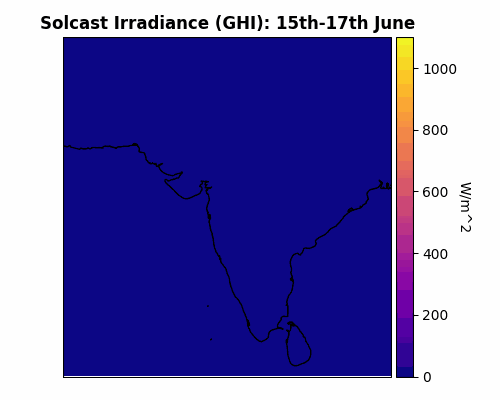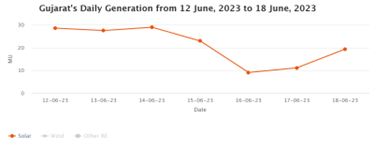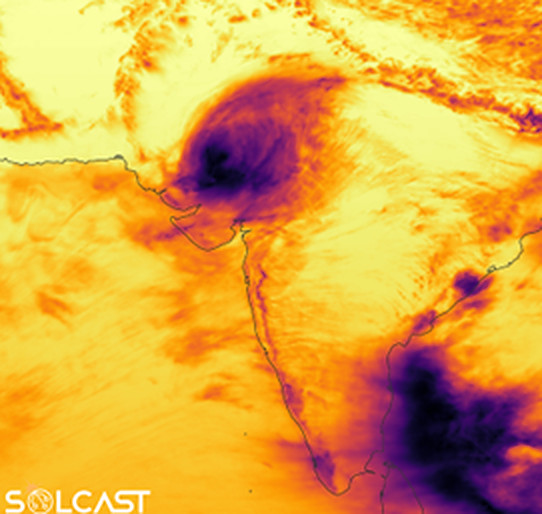Tropical Cyclone Biparjoy, meaning “disaster” in Bengali, made landfall in India’s western Gujarat state, near the southern Pakistan border, on June 15, 2023. Wind speeds reached more than 65mph and rainfall of up to 500mm led to the evacuation of over 180,000 people and the death of at least 8. It has also left nearly 1000 villages without power.

Cyclone season is from April to December in the Northern Indian basin. Although the Bay of Bengal typically sees more than twice as many cyclones, it is still common for storms to form in the Arabian Sea and move into northwestern Indian and southern Pakistan.
Solar Irradiance clearly shows the lingering impact of Cyclone Biparjoy over the region. Although by June 17 the storm had been downgraded to a “Tropical Depression” with winds and rainfall weakening, rotating clouds around the weakening core still covered a large area of northwestern India and significantly reduced solar generation by more than 50%.

Image: www.renewablesindia.in/
Elsewhere in India, solar generation was high as monsoonal activity over this period remained mostly offshore to the southeast. However, clouds with monsoonal showers are often very thick and stationary, and so solar generation where they do occur is cut much more drastically and for longer periods compared to typical showers in the mid-latitudes. An El Niño pattern is developing in the Pacific Ocean and can influence the monsoonal season in India, where it is associated with drier than normal conditions.

Image: Solcast
Solcast produces these figures by tracking clouds and aerosols at 1-2km resolution globally, using satellite data and proprietary AI/ML algorithms. This data is used to drive irradiance models, enabling Solcast to calculate irradiance at high resolution, with typical bias of less than 2%, and also cloud-tracking forecasts. This data is used by more than 300 companies managing over 150GW of solar assets globally.
The views and opinions expressed in this article are the author’s own, and do not necessarily reflect those held by pv magazine.
This content is protected by copyright and may not be reused. If you want to cooperate with us and would like to reuse some of our content, please contact: editors@pv-magazine.com.



2 comments
By submitting this form you agree to pv magazine using your data for the purposes of publishing your comment.
Your personal data will only be disclosed or otherwise transmitted to third parties for the purposes of spam filtering or if this is necessary for technical maintenance of the website. Any other transfer to third parties will not take place unless this is justified on the basis of applicable data protection regulations or if pv magazine is legally obliged to do so.
You may revoke this consent at any time with effect for the future, in which case your personal data will be deleted immediately. Otherwise, your data will be deleted if pv magazine has processed your request or the purpose of data storage is fulfilled.
Further information on data privacy can be found in our Data Protection Policy.